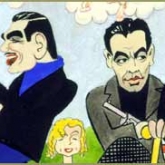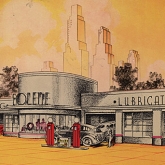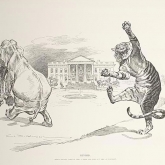Exhibitions related to Drawing and Graphic Design
Primary tabs
Displaying 1 - 7 of 7.
 |
Celebrity Caricature: Selections from the Smithsonian Institution LibrariesIn the late 1990's the Smithsonian American Art Museum and the National Portrait Gallery Library (AA/PG Library) made a special effort to collect materials on caricature and cartoon in conjunction with the National Portrait Gallery's 1998 exhibition "Celebrity Caricature in America", curated by Wendy Wick Reaves. |
 |
Doodles, Drafts & Designs: Industrial Drawings from the SmithsonianHow do ideas evolve into reality? Doodles, Drafts, and Designs: Industrial Drawings from the Smithsonian offers a fascinating glimpse into inventors' sketchbooks, engineers' mechanical drawings, and architects' renderings from the 1830s to the 1990s, to show the origins of some of the most familiar sites and devices of modern-day life. |
 |
Drawing from Life: Caricatures and Cartoons from the American Art / Portrait Gallery CollectionThe Smithsonian Institution Libraries has a substantial collection of cartoon and caricature books, including rare and special collections titles which date from 1800. Numbering over 600 volumes, this growing collection has a strong focus on works by American artists - the oldest dating to the Civil War period. |
 |
Picturing Words: The Power of Book IllustrationAndreas Vesalius, an early physician and progressive scientist, wrote the book "De Humani Corporis Fabrica" (1543) with illustrations of the human body showing muscles pulled back to see what was underneath. The illustrations of Vesalius changed the way people looked at the human form and helped develop modern medicine. Through historic illustrations in books randing from children's alphabet books to medical texts we can see what inspires and drives graphic art. |
 |
Ramelli's Machines: Original drawings of 16th century machinesThe military engineer Agostino Ramelli produced a remarkable illustrated book in 1588 describing a large number of machines that he devised. Called Le diverse et artificiose machine del Capitano Agostino Ramelli (The various and ingenious machines of Captain Agostino Ramelli), this work had a great impact in the field of mechanical engineering. The book contains 195 superb engravings of various machines along with detailed descriptions of each one in both French and Italian. The Dibner Library has original drawings of seven of the machines and this web site has been developed to further research on these artworks. |
 |
The Illustrations of the Nests and Eggs of Birds of Ohiollustrations of the nests and eggs of birds of Ohio was published in the small town of Circleville, Ohio, over a period of eight years (from 1879 to 1886) through the dedicated efforts of the family and friends of a young woman named Genevieve Jones. Despite being produced not just by amateurs but largely by women, far from the publishing houses and intellectual centers of 19th-century America, the book was hailed as an extraordinary achievement from the moment its first few plates were published. |
 |
Vibrant Visions: Pochoir Prints in the Cooper-Hewitt, National Design Museum LibraryThe pochoir process, characterized by its crisp lines and brilliant colors, produces images that have a freshly printed or wet appearance. The Cooper-Hewitt National Design Museum Library, Smithsonian Institution Libraries, has a rich collection of vibrantly colored illustrated books and periodicals that were created using this process. Explore the history of pochoir with select examples from the library's collection that illustrate costume, interior, and pattern designs produced in France from 1900 through the 1930s. |
